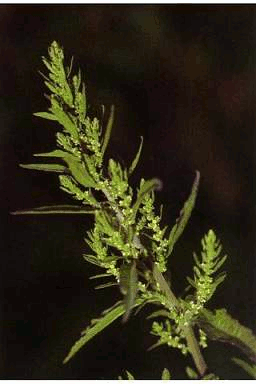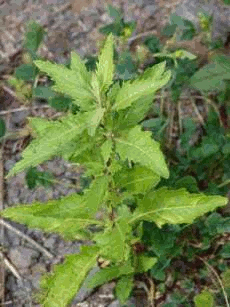Mexican Tea
Common Names: Jesuit tea, Mexican-tea, payqu (paico), epazote, mastruz, or herba sanctæ Mariæ.
Scientific Name: Dysphania ambrosioides
Climate: Cold temperate, Warm, Warm temperate.
Plant Description: The Mexican Tea is a hairy perennial herbaceous plant, up to 1 meter tall, with a fibrous and branched root and an erect, hollow and branched stem. The stem is terete to slightly angular, hairless, with conspicuous veins and of variable colors, often a combination of olive green, dull red and cream. The leaves are alternate, oval or oblong-lanceolate and serrated, reaching up to 12 cm long. They are glabrous, almost sessile, yellowish-green in color. Both the stems and the leaves have tiny glands that secrete an aromatic oil; they exude a somewhat musky medicinal aroma.
It is mainly found in dry wasteland and cultivated land. River bottoms, dry lake beds, flower beds, waste areas; at elevations up to 700 meters.
It is native to Mexico, Central and South America.
Cultivation: Full sun. It does not like the shade. It grows best in daytime temperatures between 15 to 22 °C and can tolerate 4 to 31 °C. It does not support frost. Prefers sandy soil.
It reproduces by seed. To do that put some seeds in each pot filled with fertile soil. Cover with a little soil and water. Leave the pots exposed to the sun keeping it moist. Germination rates are usually very good and the seedlings should appear within a few days of sowing the seed. When they are about 5 - 8 cm tall, thin the seedlings to keep the best plants. Plant in late spring, after the last expected frosts. Before planting it is advisable to plow the ground so that it is loose and oxygenated.
Water regularly, avoid flooding and drought.
The harvest takes place 50 days after sowing. Cut off the largest leaves so the plant can continue to reproduce. To harvest, cut the center stem first to encourage leaf production. Prune the plant frequently to avoid blooming. Don't harvest more than half of the plant at a time.
 Uses: It is known as an effective remedy to cure diseases of the urinary tract, cystitis and stomach infections, it also helps regulate menstruation and menstrual cramps. It increases the amount of milk in the lactation period. It is recognized as one of the best remedies to eliminate intestinal parasites, especially hookworms and roundworms.
Uses: It is known as an effective remedy to cure diseases of the urinary tract, cystitis and stomach infections, it also helps regulate menstruation and menstrual cramps. It increases the amount of milk in the lactation period. It is recognized as one of the best remedies to eliminate intestinal parasites, especially hookworms and roundworms.
The whole plant is analgesic, antiasthmatic, carminative, febrifuge, stomachic and vermifuge.
In the kitchen it is used as a condiment mainly while cooking beans, fish, meats, some soups, mushroom dishes, in quesadillas and other dishes. It is used as a spice to give flavor and to avoid gas. It is taken as a tea in infusions.
Do not consume the oil extracted from the immature leaves and seeds of this plant in large quantities as it can be extremely toxic and cause death.
Epazote leaf is toxic to dogs and horses.
Pests and Diseases: Mexican Tea does not attract many pests because its high content of essential oils provides effective protection against numerous pests.
References:
http://tropical.theferns.info/viewtropical.php?id=Dysphania+ambrosioides
A Modern Herbal. Grieve.,Publisher Penguin, 1984. ISBN 0-14-046-440-9
A Field Guide to Medicinal Plants. Eastern and Central N. America. Foster. S. & Duke. J. A., Publisher Houghton Mifflin Co.,1990. ISBN 0395467225
https://efsa.onlinelibrary.wiley.com/doi/abs/10.2903/j.efsa.2012.2663
5https://efsa.onlinelibrary.wiley.com/doi/abs/10.2903/j.efsa.2012.2663
